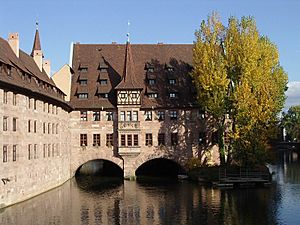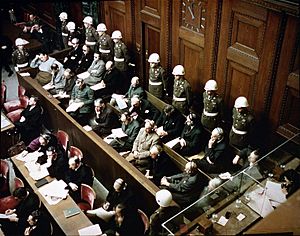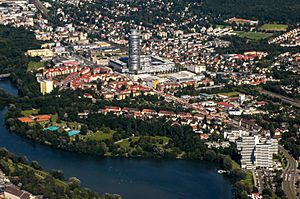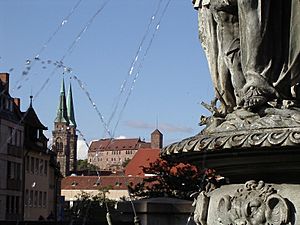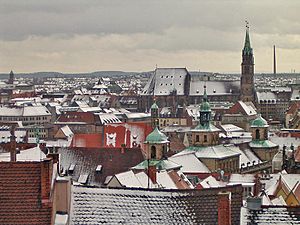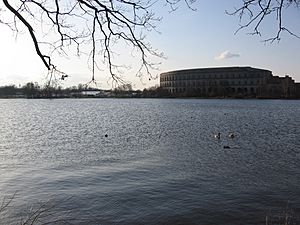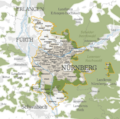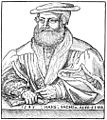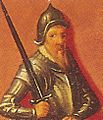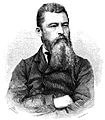Nuremberg facts for kids
Quick facts for kids
Nuremberg
|
||
|---|---|---|
|
||
| Country | Germany | |
| State | Bavaria | |
| Admin. region | Mittelfranken | |
| District | Kreisfreie stadt | |
| Subdivisions | 7 Stadtbezirke | |
| Elevation | 309 m (1,014 ft) | |
| Population
(2022-12-31)
|
||
| • Total | 523,026 | |
| Time zone | CET/CEST (UTC+1/+2) | |
| Postal codes |
90001 – 90491
|
|
| Dialling codes | 0911, 09122, 09129 | |
| Vehicle registration | N | |
| Website | www.nuernberg.de | |
Nuremberg (German: Nürnberg) is a big city in the German state of Bavaria. It is located in a region called Middle Franconia. The city sits on the Pegnitz River and the Rhine-Main-Danube Canal. It is the largest city in Franconia. Nuremberg is about 170 kilometers (105 miles) north of Munich. In December 2012, about 495,121 people lived there.
Contents
Nuremberg's Past: A Quick Look
How Nuremberg Grew in the Middle Ages
From 1050 to 1571, Nuremberg became a very important city. It was located on major trade routes. Many meetings of the Holy Roman Empire, called Reichstage, took place at Nuremberg Castle. These meetings were a key part of how the empire was run.
In 1219, Emperor Frederick II made Nuremberg an Imperial Free City. This meant the city was directly ruled by the Emperor. It was not controlled by local lords or princes. Nuremberg also gained a seat in the Imperial Parliament.
In 1298, a terrible event happened. Nearly 700 Jewish people were killed in a violent attack. This event allowed the city to connect its northern and southern parts. Today, this area is home to the City Market, Frauenkirche, and City Hall.
Nuremberg in Early Modern Times
In 1532, the Peace of Nuremberg was signed. This agreement gave important rights to followers of Lutheranism. During the Thirty Years' War in 1632, the city faced a big attack. The Imperial general Albrecht von Wallenstein tried to take the city from King Gustavus Adolphus of Sweden.
After this war, Nuremberg became less important. It only started to grow again in the 1800s. The city became a major industrial center.
By the early 1800s, Nuremberg was almost out of money. In 1806, the Holy Roman Empire ended. Nuremberg then became part of the Kingdom of Bavaria. Bavaria helped the city by taking over its debts. In 1835, the first German railway opened. It connected Nuremberg to the nearby town of Fürth.
Nuremberg During the Nazi Period
Nuremberg played a big role during the time of Nazi Germany. The Nazi Party held huge yearly meetings there. These events were called the Nuremberg rallies. They took place from 1927 to 1938.
After Hitler's rise to power in 1933, the rallies became massive events. They were used to spread Nazi ideas. These ideas included strong feelings against Jewish people. At one rally, Hitler introduced the Nuremberg Laws. These laws took away German citizenship from all Jewish people. Many buildings were built for these rallies, but some were never finished.
Today, you can still see examples of Nazi architecture in the city. Nuremberg was also home to Julius Streicher. He was a Nazi who published a newspaper called Der Stürmer.
During World War II, Nuremberg was a military center. It was important for making war supplies. This included airplanes, submarines, and tank engines. A subcamp of the Flossenbürg concentration camp was also located here. Many factories used forced labor.
The city was heavily bombed during World War II. This happened mostly between 1943 and 1945. On January 2, 1945, the old city center was bombed. About 90% of it was destroyed in just one hour. Around 1,800 people died, and 100,000 lost their homes. More attacks followed in February 1945. In total, about 6,000 Nuremberg residents died from air raids. After the war, the city was rebuilt. Many medieval buildings were restored to look like they did before the war.
Between 1945 and 1946, important German officials were put on trial. These trials were called the Nuremberg Trials. They focused on crimes committed during the war, including the Holocaust. Nuremberg was chosen for these trials for several reasons:
- It was in the American occupation zone.
- The Nuremberg Palace of Justice was large and not badly damaged. It also had a big prison.
- The city had hosted the Nazi party's rallies. Holding the trials there had a strong symbolic meaning.
The same courtroom was later used for other trials. These were organized by the United States.
Nuremberg's Economy
Nuremberg is known for its special foods and products. These include gingerbread (Lebkuchen), sausages, and handmade toys. The first pocket watches, called Nuremberg eggs, were made here in the 1500s. In the 1800s, Nuremberg became the "industrial heart" of Bavaria. Big companies like Siemens and MAN started here.
Today, the area makes electrical equipment, mechanical and optical products, and vehicles. Siemens is still the biggest industrial employer in the region. Also, one-third of all German market research companies are in Nuremberg.
The Nuremberg International Toy Fair is the largest toy fair in the world. The city also hosts many high-tech fairs each year. These events bring experts from all over the world.
Culture in Nuremberg
Nuremberg was an early center for learning, science, and new inventions. The city greatly helped the study of astronomy. In 1471, Johannes Mueller built an observatory in Nuremberg. He published many important star charts. In 1515, Albrecht Dürer, who was from Nuremberg, mapped the stars. He created the first printed star charts.
Printers and publishers have a long history in Nuremberg. Many worked with famous artists to create beautiful books. In 1470, Anton Koberger opened Europe's first print shop in Nuremberg. In 1493, he published the Nuremberg Chronicles. This was an illustrated history of the world. Martin Behaim, a famous mapmaker, also created the first world globe here.
Famous sculptors like Veit Stoss and Peter Vischer also worked in Nuremberg. The guilds of the Meistersingers, who were skilled artisans and singers, were very active here. The composer Richard Wagner made Hans Sachs, a famous Meistersinger, the hero of his opera Die Meistersinger von Nürnberg. Johann Pachelbel, a Baroque composer, was born here.
Nuremberg is also famous for its Christmas market. Over a million people visit it every year.
What to Eat in Nuremberg
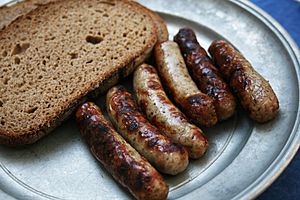
Nuremberg is known for its Nürnberger Bratwurst. These sausages are shorter and thinner than other bratwursts.
Another special food is Nürnberger Lebkuchen. This is a type of gingerbread. People mostly eat it around Christmas time.
Main Sights to See
The southern part of the old town is called Lorenzer Seite. It is separated from the north by the Pegnitz River. The city walls surround it on the south.
- Nuremberg Castle: This includes three castles that stand above the city.
- Heilig-Geist-Spital: This Hospital of the Holy Spirit was founded in 1332. It was one of the largest hospitals in the Middle Ages. Today, it is a home for older people and a restaurant.
- Hauptmarkt: This main market square is very pretty. It is famous for gingerbread. Nuremberg's most famous sight here is the Gothic Schöner Brunnen (Beautiful Fountain). It was built around 1385. The one you see today is a copy. The original is in the Germanisches Nationalmuseum.
- The Johannisfriedhof is an old cemetery. It has many old graves, including those of Albrecht Dürer and Willibald Pirckheimer.
- There is also a medieval market inside the city walls. It sells handmade goods.
- The German National Railways Museum is in Nuremberg.
- The Nuremberg Ring is said to bring good luck if you touch it. It is now part of an iron fence.
Getting Around Nuremberg
Train Travel in Nuremberg
Nuremberg was the first city in Germany to have a railway. Today, Nuremberg Central Station is a major stop. It serves fast IC and ICE trains. The high-speed line to Munich opened in 2006. Trains on this line can go up to 300 km/h (186 mph). This means you can travel to Munich in just one hour.
Public Transport in Nuremberg
Nuremberg has a good public transport system. It includes subways, suburban trains, trams, and buses.
Sports Teams in Nuremberg
- 1. F.C. Nuremberg (a football club)
- Thomas Sabo Ice Tigers (a professional hockey club)
Sister Cities Around the World
Nuremberg is twinned with many cities across the globe:
 France Nice, since 1954
France Nice, since 1954 Poland Kraków, since 1979
Poland Kraków, since 1979 Macedonia Skopje, since 1982
Macedonia Skopje, since 1982 Scotland Glasgow, since 1985
Scotland Glasgow, since 1985 Nicaragua San Carlos, since 1985
Nicaragua San Carlos, since 1985 Germany Gera, since 1988, renewed 1997
Germany Gera, since 1988, renewed 1997 Czech Republic Prague, since 1990
Czech Republic Prague, since 1990 Ukraine Kharkiv, since 1990
Ukraine Kharkiv, since 1990 Israel Hadera, since 1995
Israel Hadera, since 1995 China Shenzhen, since 1997
China Shenzhen, since 1997 Turkey Antalya, since 1997
Turkey Antalya, since 1997 Greece Kavala, since 1998
Greece Kavala, since 1998 USA Atlanta, since 1998
USA Atlanta, since 1998 Italy Venice, since 1999
Italy Venice, since 1999 Netherlands Rotterdam
Netherlands Rotterdam
Images for kids
-
Max-Morlock-Stadion is the soccer stadium of Bundesliga club 1. FC Nürnberg
See also
 In Spanish: Núremberg para niños
In Spanish: Núremberg para niños



